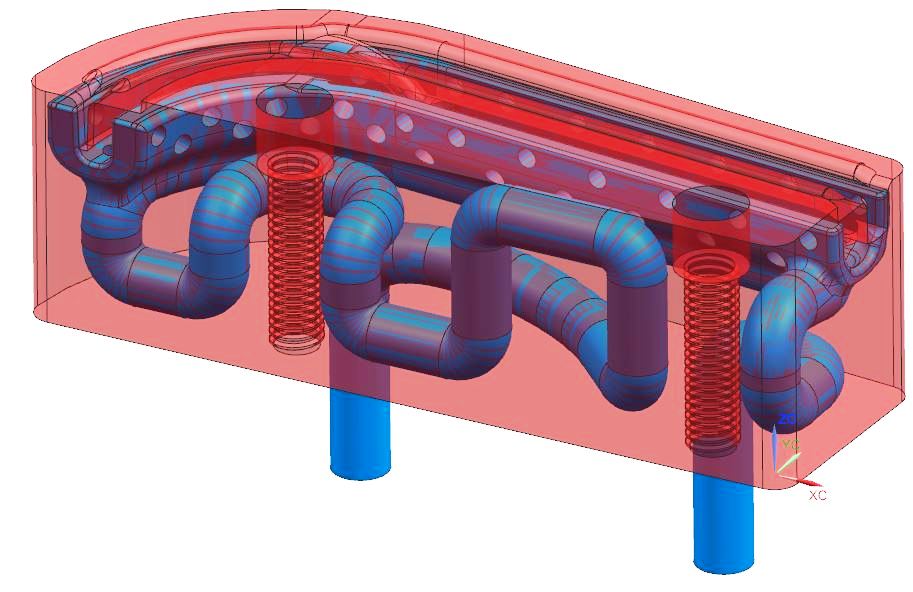
In today’s complex manufacturing environment, delivering the right parts–at the right time and price–is a constant challenge. And during injection molding, the cooling stage is typically the longest time period in the process. During this stage, the part must reach a low enough temperature so that the physical properties of the material and the dimensional integrity of the molded part are realized.
Lengthy cooling times can be frustrating, and present a major impact on the capacity of your machines. It can also be especially challenging to reduce cooling and cycle times when mass-producing complex components for applications like aerospace, automotive, or medical–with little tolerance for expensive, time-consuming inconsistencies like warping, or dents and craters.
So how do you reduce cooling times and streamline manufacturing overall? Our team uses a unique additive manufacturing solution called conformal cooling to increase productivity in applications like injection molding, die-casting, and production of thermoset tools. By integrating custom 3D printed cooling lines into industrial molds and tooling, we help other manufacturers increase plant capacity and improve quality, performance, and volume in parts.
What is Conformal Cooling in Injection Molding?
Traditional cooling mechanisms designed in straight lines only provide coverage to a partial outline of the part’s geometry in the mold. Conformal cooling lines are 3D printed to reach all the unique contours of a part’s geometry in the mold or tooling inserts. Conformal lines are therefore less restricted as to where they are placed in the tooling.
Temperature control is crucial in injection molding, as the mold heats up as molten plastic is injected into it. With conventional cooling techniques, the temperature of the mold often rises over the threshold for ejecting a successful part–wasting time and money while the mold cools to an acceptable temperature for part ejection. Conformal cooling, however, maintains a nominal temperature, allowing for a more rapid temperature reduction so that the overall cycle times are reduced each time the mold opens and closes.
3D Design and Printing for Conformal Cooling
When considering conformal cooling as a solution, we analyze both the part and associated mold details to identify which would benefit most from conformal cooling inserts. These details could be mold cores, cavities, slide faces, lifters, or any combination of these. We then design a cooling strategy so that optimum cooling conditions are realized. This process often makes feasible the ability to cool areas not adequately addressed such as radiused corners or tall or thick ribbed details. Above all, it allows for the cooling lines to “conform” to the actual part geometry. The result creates opportunities for broader process windows and process controls, resulting in reduced overall cycle time.
3D printing and conformal cooling create endless possibilities for engineers engaged in industrial manufacturing. Some consider conformal cooling to be one of the most important uses for 3D printing today, highlighting two of this technology’s greatest benefits: freedom in design, and the ability to create sophisticated geometries previously impossible via traditional manufacturing.
Although we provide a variety of services, our engineers typically use Direct Metal Laser Melting (DMLM) to open up more opportunities in design and production for examples like traditionally drilled machined water lines. For that type of project, conformal cooling makes a tremendous difference in production as the process allows lines filled with water to follow the complex shape–including cross sections–of each part.
DMLM additive manufacturing technology makes it possible to customize your small-to medium-sized parts and inserts in days rather than the weeks or months associated with traditional manufacturing. This metal 3D printing process expands freedom in design-driven manufacturing, produces extremely high-quality, repeatable injection molded parts, and accelerates production on every level, improving time to market.
When Should I Use Conformal Cooling?
We recommend conformal cooling (especially for plastic injection molding) when:
- Cycle times are longer than predicted or budgeted.
- The dimensional integrity of your molded parts is non-conforming.
- Traditional manufacturing methods are limiting your mold’s cooling features.
- Improper cooling is causing deformed parts, resulting in excessive scrap costs.
Shapeways Process
Our engineers performed a recent study, further validating this process. In the example studied, results demonstrated a 69% reduction in cooling time. Software analysis also verified that the modified sample cooling channels revealed a more uniform temperature distribution when compared to the original cooling design.
During actual manufacturing environments, our customers running 70-80 parts an hour with traditional cooling lines or channels typically increase their output to an impressive 140 parts an hour with 3D printed conformal cooling inserts.
Shapeways for Conformal Cooling
The impact and efficiency of conformal cooling can transform production for your company, and accelerate growth. In 2022, Shapeways further expanded its traditional manufacturing capabilities with the acquisition of Linear AMS, an expert in injection molding known for innovative solutions like conformal cooling. Linear’s true, consultative approach made them a trusted partner in solving the toughest manufacturing challenges and Shapeways has continued with that legacy.

